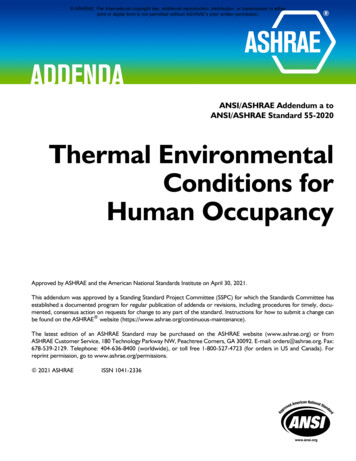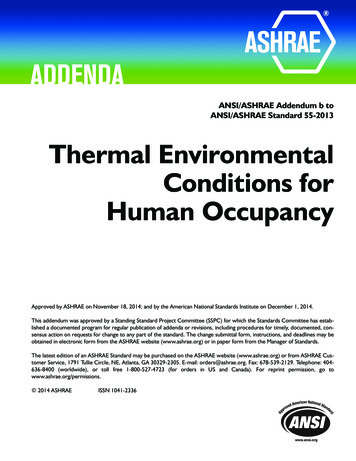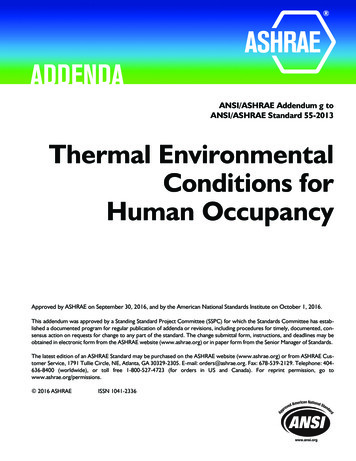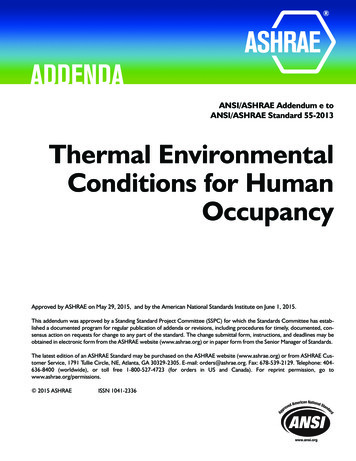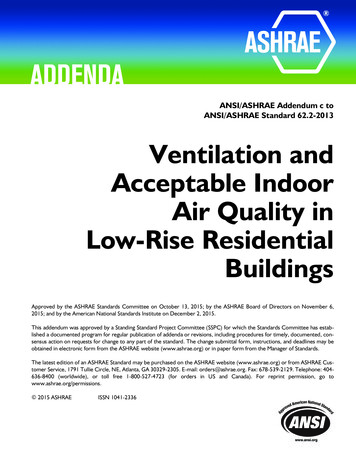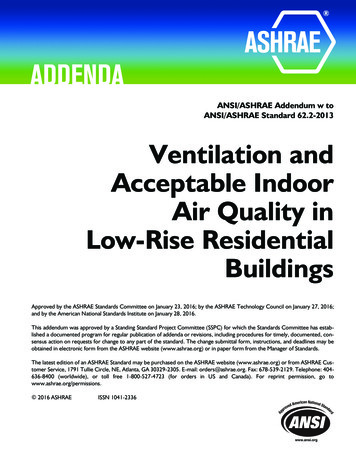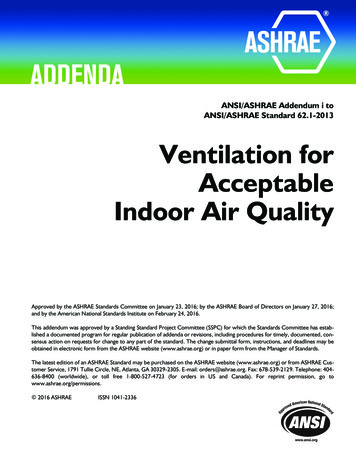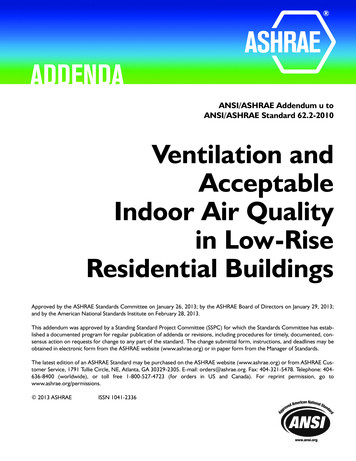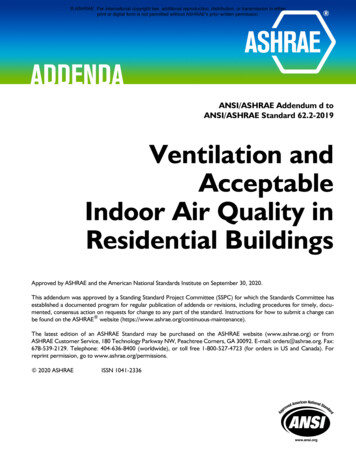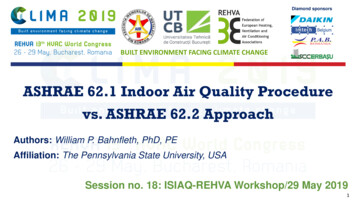
Transcription
The Convergence of ASHRAE Standard 90.1, 62.1 and55 – Example of Energy Efficiency MeasuresChonghui Liu (CL), PE, CEM, LEED APTeam Leader, Energy ServicesPopli Design Group2018 CNY Engineering ExpoOncenter, Syracuse, NYMonday, November 12, 2018
Disclaimer The results of the case studies do not reflect the resultsfrom any specific project. The views expressed in the case studies are the author’sonly, they do not necessarily reflect the views of ASHRAESPPC 90.1 or other parties. The images referenced in this presentation are forgeneral information only, they do not reflect any specificsite.
Content ASHRAE standards – comparison and applicationo 90.1o 62.1o 55 Examples of energy efficiency measuresooooBuilding Envelope – attic roof insulationHVAC – VAV AHUs in lecture hallsHVAC – kitchen DCVHVAC – laboratory ventilation Q&A
Learning Objectives Comparison and application of ASHRAE standardso 90.1o 62.1o 55 Learn the three ASHRAE standards from examples ofenergy efficiency measuresooooBuilding Envelope – attic roof insulationHVAC – VAV AHUs in lecture hallsHVAC – kitchen DCVHVAC – laboratory ventilation Q&A
Do you know who you are talking to? Consulting engineers/managersFacility engineers/managersManufacturer engineers/managers/salesContractors/construction /studentsOthersFeel free to ask questions at any point during the presentation.
ASHRAE Standards4,000 Energy: Standard 90.1-2016: Energy Standard for Buildings Except Low-RiseResidential Buildings Standard 90.2-2007: Energy Efficient Design of Low-Rise ResidentialBuildings Standard 90.4-2016: Energy Standard for Data Centers Standard 100-2015: Energy Conservation in Existing BuildingsCommissioning: Standard 202-2013: Commissioning Process for Buildings andSystems Guideline 0-2013: The Commissioning Process
ASHRAE Standards4,000 Other Resources for HVAC Design: Standard 15-2016 & 34-2016: Safety Standards for RefrigerationSystems & Designation and Safety Classification of Refrigerants Standard 55-2013 (2017): Thermal Environmental Conditions forHuman Occupancy Standard 62.1-2016: Ventilation for Acceptable Indoor Air Quality Standard 169-2013: Climate Data for Building Design Standards Standard 189.1-2014: Standard for the Design of High-PerformanceGreen Buildings
Convergence Building Envelope (Ch 5)HVAC (Ch 6)Service water heating (Ch 7)Power (Ch 8)Lighting (Ch 9)Other equipment (Ch 10)90.1Energy62.1IEQ55ThermalComfortTo provide acceptable indoor air quality and thermalenvironmental conditions for human occupancy whileoptimizing energy efficiency in built environment.
History Oil embargo 1973 Standard 90-75 Standard 62-73 Standard 55-66Picture from www.wsj.comPicture from www.thesleuthjournal.com
Comparison
Comparison – 90.1 compliance paths Ch. 4: Administration and Enforcemento New Buildingso Additions to existing buildingso Alterations of existing buildings
Comparison – sections most used (by engineers) 90.1 min equipment efficiency tables 62.1 - min ventilation rates tables 55 - comfort zone psychrometric charts
Comparison – sections most used (by engineers )90.1 min equipment efficiency tables1.2.3.4.5.6.7.8.9.10.11.12.13.14.15.16.AC - Electric unitary AC and condensing unitsAppendix F - DoE:HP - Electric unitary and applied HPs AC and HPChillers - water chilling packages Water heatersElectric packaged ACs and HPs Pool heatersFurnace - Warm-air furnaces (and ACs)BoilersHeat rejectionHeat transfer (no data)UnregulatedElectric VFR ACsElectric VRF HPsACs and condensing units serving computer roomsCommercial refrigerator and freezersCommercial refrigerationIndoor pool dehumidifiers (vapor compression based)Electric DX-DOAS (without energy recovery)Electric DX-DOAS (with energy recovery)Questions or comments?
EEM Examples Building Envelope – attic roof insulationHVAC – VAV AHUs in lecture hallsHVAC – kitchen DCVHVAC – laboratory ventilation
Building Envelope – Attic Roof Insulation 90.1 – Chapter 5o 5.4: Air Leakage Continuous air barrier New: building pressurization test 0.4 cfm/ft2 under 0.3 in. of watero 5.5: Table 5.5-0 to 5.5-8Climate 5AResidential (except low-rise)Min. R-49o 5.7: Future: envelope Cx?Comments? 6.7: HVAC IECC: HVAC/Plumbing/Lighting Controls 62.1 and 55 - Vented attico Eliminate moisture from belowo Prevent melting snow and ice dams forming
Building Envelope Climate zone: 5A Residence halls on a university Existing condition:ooooooFlat upper roof with EPDMSloped sides with original slate shinglesSolid wood deckWood/steel structural framing belowCellulose insulation 3.5 inches R-11 (ASHRAE Fundamental)Cracks/penetrations Energy:o Heat conduction thru ceilingo Heat loss from air leakage below
Building Envelope Recommendation:o Remove cellulose insulationo 5.4 Continuous air barrier - Sealcracks/penetrations of attic flooro 5.5 Min R-49 - R-50 insulation(ASHRAE Fundamental): Closed cell spray foam 2 inches Blown-in cellulose insulation 10inchesPicture from www.tcworks.org Benefits besides energy savings:ooooooPerform under low tempSeal entire attic floorAir and vapor barrierAcoustical barrierNo harmful additivesProtected – flame retardantPicture from www. greenintegrateddesign.com
Building EnvelopeSummary:Building Envelope EEM – Attic Roof InsulationValueUnitAnnual electric energy savings0kWh/yrAnnual electrical energy cost savings 0 /yrAnnual natural gas energy savings200,000therm/yrAnnual natural gas energy cost savings 120,600 /yrTotal annual energy cost savings 120,600 /yrTotal project cost 600,000 Simple payback periodLife cycle cost5.0 650,000yr Questions or comments?
HVAC – VAV AHUs in Lecture Halls90.1 – Chapter 6 6.4:o Minimum efficiency tables 6.8.1-1 RTU/AHU with elec. AC Not for CW/HW AHUso Automatic shutdown Time switch or scheduling controlOccupant sensorsManually operated timerInterlock to security systemo DCV 500 ft2 25 people/1000 ft2 ( 40 people/1000 ft2 in 90.1-2010)1 or more: Economizer /Modulating / 3,000 CFM OADefinition: OA – number of people Occupancy schedule Occupancy sensorsKDCV People counters CO2 sensorso Zoneo Return air ducto CO2 sampling Exceptions: exhaust energy recovery comply with 6.5.6.1
HVAC – VAV AHUs in Lecture Halls90.1 – Chapter 6 6.5:ooooooo 6.7:Air economizer: 5A 54,000 Btu/h (4.5 tons)Prevent simultaneous H/C: Dual-duct except snap acting controlsVary supply airflow – loadStatic pressure reset – zone requiring most pressureMulti-zone supply air temp reset – load or OATRequired OA rate – larger of OA or EA by 62.1EA energy recoveryo System Cx: 50,000 ft2 conditioned areao IECC 2015: 480 MBH (40 tons) 600 MBH for hvac dhw
HVAC – VAV AHUs in Lecture Halls 62.1 – Procedureso IMC: 6.2 and 6.4Section 6 ProceduresSection 6.1 GeneralSection 6.2VentilationRate ProcedureSection 6.3IAQ ProcedureSection 6.4NaturalVentilationProcedureSection 6.5 Exhaust VentilationSection 6.6 Design DocumentationProceduresCombination
Ez: zone air distribution effectiveness Cooling Heating Induced ventilationEv: system ventilation efficiency Zpz: primary OA fraction Appendix A
HVAC – VAV AHUs in Lecture Halls62.1 6.2:o Breathing zone OA: CFM-people CFM-area (Table 6.2.2.1)o Dynamic reset – DCV (required by 90.1) 500 ft2 25 people/1000 ft2 – Examples below(90.1-2007/2010 40p/1000 ft2 – 90.1-2013/2016 25p/1000 ft2) 1 or more: Air economizer Automatic modulating control of OA damper Design OA 3,000 CFM Correctional booking/waitingDaycareClassroomLecture classroomLecture hallUniversity labMedia centerMusic / theater / danceMulti-use assembly Restaurant diningCafeteriaBars, cocktail loungeConferenceLobby / pre-functionBreak roomReception areaTransportation waitingAuditorium seating Religious worshipCourtroomLegislative chamberMuseum / galleryMall common areaBarbershopSpectator areaDance floorGambling casino
HVAC – VAV AHUs in Lecture Halls90.1 6.5.7.1Transfer Air62.1 2016 - 5.16/17 Air Classification (subjectivecriteria) and RecirculationIMC 2015 – Section 403 Class 1: suitable for recirculation/transfer, e.g.office, common, classrooms In excess of required OA, notprohibit recirculated as acomponent of SA. Not prohibited if 10% OA,e.g. toilets, wood/metal shops,locker rooms, science labs, artclassrooms, prison cells withplumbing fixtures. Not recirculated/transferred toany spaces or within e.g. repairgarages, beauty/nail/pet shops,fuel station, kitchen, smokinglounges. Class 2: recirculation/transfer to similar Class2/3e.g. locker, gym, bathrooms o Exception: Class 2 to 1: permitted with ERdevice, ando Recirculated Class 2 10% OA. Class 3: only recirculated within, e.g. chem/biolabs, trash rooms, kitchen hoods o Exception: Class 3 to other space: permittedwith ER device, ando Recirculated Class 3 5% OA. Class 4: harmful – Not recirculated/transferred toany spaces or within, e.g. kitchen grease hoods,paint booth, chem storage ETS: Not recirculated/transferred from ETS area toETS-free areaKitchen
HVAC – VAV AHUs in Lecture Halls55 Thermal comfort: that condition of mind that expresses satisfaction with thethermal environment and is assessed by subjective evaluation.Picture from www.nzdl.orgCh 9 FundamentalsTa ToIECC: Design Conditions for Load Heat 72F (e.g. 68) Cool 75F (e.g. 75, 72, 68)
HVAC – VAV AHUs in Lecture Halls Climate zone: 5A Lecture halls on a university Existing condition:o Originally constructed in 1960so 20 lecture halls, concourse and supporting areaso 17 AHUs in mech rooms throughout the building 2 large dual-duct AHUs ( 40% of total CFMs) 2 multi-zone AHUs 13 single-zone AHUsoooooooooChilled water and hot water coilsConstant volume (VFDs on SFs, but soft-start only)Preheating coils not usedMixing hot and cold air flows (simultaneous heat and cool)High static pressurePneumatic zone temp sensors campus BASPneumatic dampers and zone air flows campus BASIneffective pneumatic damper controlsNo fan controls to balance SA and RA
HVAC – VAV AHUs in Lecture HallsPicture from 2016 ASHRAE Handbook - Systems
HVAC – VAV AHUs in Lecture HallsAHU No.AHU-1 2AHU-3 4AHU-5 17TotalAHU Supply Fan and Return Fan ScheduleCombined SA Combined RACombined SFCombined RF(CFM)(CFM)Motor (HP)Motor 117.534198,000163,000242.554.5AHU TypeDual ductMulti-zoneSingle-zonePicture from 2016 ASHRAE Handbook - Systems
HVAC – VAV AHUs in Lecture HallsPicture from 2016 ASHRAE Handbook - Systems
HVAC – VAV AHUs in Lecture Halls Recommendation:oooooooooooooReplace 2 2 13 AHUs with new VAV AHUsReplace dual-duct boxes/Pneumatic with VAV boxes/DDCReplace ductwork (liner) and diffusers due to age/conditionDCV in each lecture hall using CO2 sensorsEnthalpy economizer controlsEnthalpy energy recovery with bypassChilled water control valves from space thermostatHot water control valves from space thermostatStatic pressure reset controls for SFs in 2 2 AHUsSA temp reset based on scheduling and space thermostatDDC integration with campus BASAir system TABCommissioning Energy savings:o AHU SF and RA powero Prevent simultaneous heat/cool (and economizer free cooling)o Heat/cool energy from reduced OA from DCV
HVAC – VAV AHUs in Lecture Halls 6.5.6.1 Exhaust Air Energy Recovery :o Y/N:1) 8000 hrs.2) Climate zone.3) %OA design.4) SA cfm.o Enthalpy recovery ration 50% at both heating and coolingo Bypass both OA and EA1) % through energy recovery – cannot stop2) OA dP thru HR psi and EA dP thru HR psiPicture from Trane – Engineering Bulletin
HVAC – VAV AHUs in Lecture Halls 6.5.6.1 Exhaust Air Energy Recovery :o Design – control sequence examples (fixed DB):SFEFERWBDOffOffOffShutOnOffOffOpenOnOnOnShutOA 15F (adj)ERW slowed to maintain EATmin 32F (adj)
HVAC – VAV AHUs in Lecture Halls 6.5.6.1 Exhaust Air Energy Recovery :o Design – control sequence examples(fixed DB):Mode6975ConditionERWOABPEABPCCHCPHCA Cooling with EROAT RAT (75F)OAT ESP (69F)OnClosedClosedOnOffOffB Cooling no ERRAT (75F) OAT ESP (69F)OffOpenOpenOnOffOffC Cooling EconomizerOAT ESP (69F)OAT RAT (75F)OffOpenOpenOffOffOffPart load Eco“Free Heat” 1OAT ESP (69F)OAT RAT (75F)OnOpenOpenOffOffOffPart load Eco“Free Heat” 2OAT ESP (69F)OAT RAT (75F)OnClosedModulate– SATOffOffOffHeating with ER 3OAT ESP (69F)OAT RAT sedModulate– SATOffOffOnOnClosedClosedOffOnOnDHeating withERHeating withER&Preheat,EFrostProtectionPart load Eco“Free Heat” 1Part load Eco“Free Heat” 2Heating with ER 3OAT FPSP (35F)
HVAC – VAV AHUs in Lecture Halls 6.5.6.1 Exhaust Air Energy Recovery :o Design – other considerations: ER types: ER wheel, plate HX, heat pipe, run-around coil Enthalpy or DB? - Climate 5A(“Economizer high limit controls and Why Enthalpy Economizers Don’t Work”Taylor, ASHRAE Journal, Nov, 2010.)
HVAC – VAV AHUs in Lecture Halls 6.5.6.1 Exhaust Air Energy Recovery :o Construction (commissioning):Picture from DospelPicture fromwww.swinter.com
HVAC – VAV AHUs in Lecture Halls Implementation considerations:oooooooAsbestos-containing insulation found – abatement.Lead and PCB not found yet.Phased constructionTemporary relocation – major disruptionEvaluate existing fan performanceEvaluate distribution ductwork (leakage, insulation, liner, etc.)Not included in the EEM – HW/CH constant pumps to VFDsHVAC EEM – VAV AHUsValueAnnual electric energy savings560,000Annual electrical energy cost savings 43,680Annual natural gas energy savings45,000Annual natural gas energy cost savings 26,928Total annual energy cost savings 70,608Total project costSimple payback periodLife cycle costUnitkWh/yr /yrtherm/yr /yr /yr7,500,000 106.2 10,800,000yr Questions or comments?
HVAC – Kitchen DCV 90.1 – Chapter 6o 6.5.7.2 Kitchen ExhaustSystems: Replaceme
The Convergence of ASHRAE Standard 90.1, 62.1 and 55 –Example of Energy Efficiency Measures Chonghui Liu (CL), PE, CEM, LEED AP Team Leader, Energy Services Popli Design Group 2018 CNY Engineering Expo Oncenter, Syracuse, NY Monday, November 12, 2018 The results of the case studies do not reflect the results from any specific project. The views expressed in the case studies are the .

